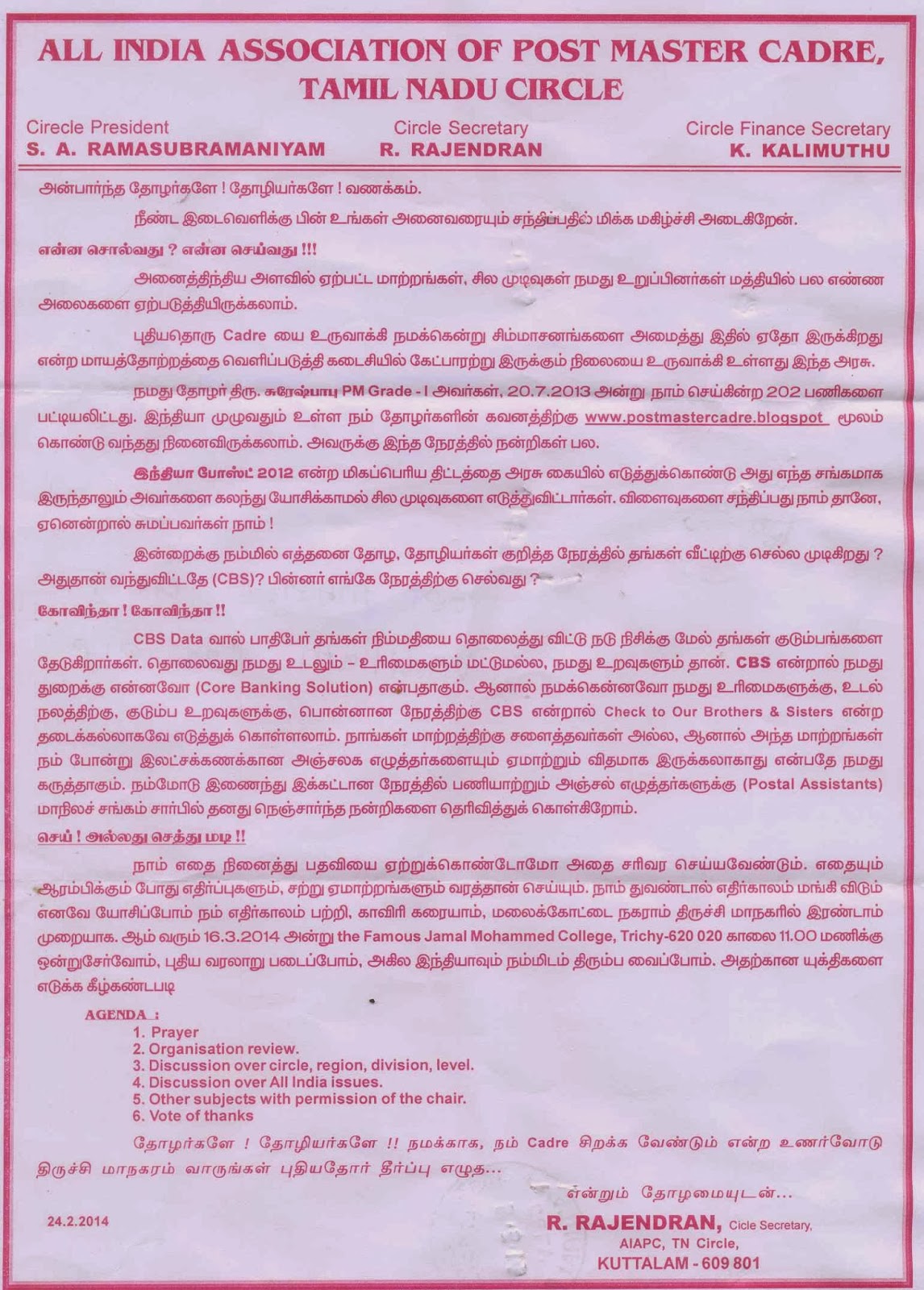K.Kalimuthu, General Secretary, CHQ Camp at TNagar HPO, Chennai 600017(TN), Mobile 9566330927, 8667686382,
Please eMail your grievances/suggestions if any to aiapstncircle@gmail.com
The recognized service association to protect the welfare of the Postmaster cadre/LSG line/MACP officials...
Saturday, March 15, 2014
Transfer Policy to regulate transfers of officers/officials, other than the officers of Indian Postal Service, Group 'A' of Department of Posts
Consolidated Transfer Policy Transfer Policy to regulate transfers of officers/officials, other than the officers of Indian Postal Service, Group 'A' of Department of Posts.
1. Rule - 37 of Postal Manual, Vol. IV
2 Rule - 38 of Postal Manual, Vol. IV
3. Request for temporary inter-circle transfer
4. Rotational transfers
5. Posting / transfer of Women Employees.
Should the GRADE PAY STRUCTURE continue in the 7th CPC too?
Once every 10 years, the Central Government revises the pay grades of its employees. It is common knowledge that the Cabinet had ordered the formation of the 7th CPC (CENTRAL PAY COMMISSION) and has also given its approval to the TERMS OF REFERENCE.
The Central Government has, until now, constituted six CPCs. The 6th CPC has the distinction of having introduced the GRADE PAY STRUCTURE. Until then, there was only the PAY SCALE. It was the 6th CPC that changed it to PAY BAND, GRADE PAY and PAY IN THE PAY BAND. It was then said that the reconstitution was made to reduce the number of categories in the PAY SCALE. They also explained how GRADE PAY was calculated.
Friday, March 7, 2014
APTITUDE QUESTIONS AND ANSWER FOR PA / SA EXAM 2014
1. A boat moves downstream at the rate of 8 kmph and upstream at a rate of 5 kmph. The speed of the boat in still water is?
1. 6 kmph
2. 6.5 kmph
3. 7 kmph
4. 7.5 kmph
Ans: 2
2. The number 6 400 082 in words is?
a) six million, four thousand, eighty two
b) six million, forty thousand, eighty two
c) six million, four hundred, eighty two
d) six million, four hundred thousand, eighty two
e) sixty four million, eighty two
Ans: D
Wednesday, March 5, 2014
Tuesday, March 4, 2014
RBI extends deadline to exchange pre-2005 currency notes
MUMBAI: The Reserve Bank of India on Monday granted an additional nine months for the public to exchange currency notes printed before 2005, including Rs 500 and Rs 1,000 denominations, and set a deadline of January 1, 2015.
"RBI has also advised banks to facilitate the exchange of these notes for full value and without causing any inconvenience whatsoever to the public," the central bank said in a release.
It clarified that the public "can continue to freely use these notes" for transactions and can unhesitatingly receive these notes in payment as all such notes remain legal tender.
The RBI on January 22 said it would withdraw from circulation all pre-2005 currency notes from April 1 and the public was advised to approach banks to exchange such notes.
Currency notes issued before 2005 do not have the year of printing on the reverse side. In notes issued after 2005, the year of printing is visible at the bottom of the reverse side.
The RBI said the withdrawal is in conformity with the standard international practice of not having multiple series of notes in circulation at the same time.
"A majority of such notes have already been withdrawn through the banks and only a limited number of notes remain with the public" the RBI said.
The apex bank said it will monitor and review the withdrawal and exchange process so that the public is not inconvenienced in any manner.
Reserve Bank governor Raghuram Rajan had earlier said the withdrawal was not an attempt at demonetisation, nor had it anything to do with the forthcoming general election.
Post-2005 notes have added security features and help in curbing the menace of fake currency.
At present, currency notes are issued in denominations of Rs 5, Rs 10, Rs 20, Rs 50, Rs 100, Rs 500 and Rs 1,000.
Earlier, the RBI had withdrawn a certain series of currency notes at the bank level but bearers were not asked to get them replaced.
Subscribe to:
Posts (Atom)




